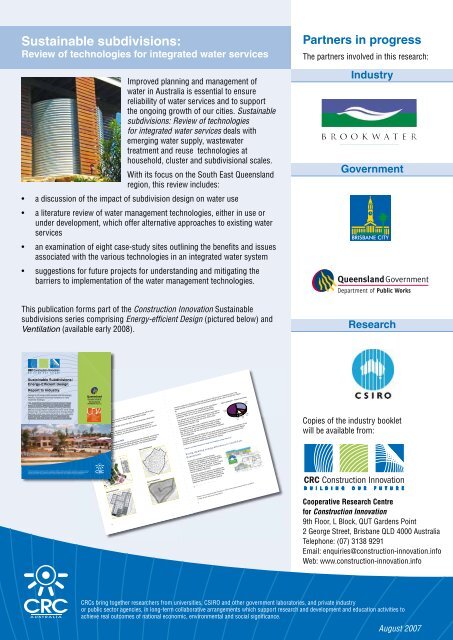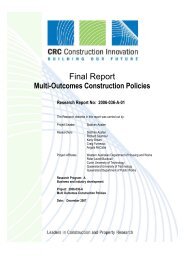Sustainable subdivisions - Construction Innovation
Sustainable subdivisions - Construction Innovation
Sustainable subdivisions - Construction Innovation
- No tags were found...
Create successful ePaper yourself
Turn your PDF publications into a flip-book with our unique Google optimized e-Paper software.
<strong>Sustainable</strong> <strong>subdivisions</strong>:Review of technologies for integrated water servicesImproved planning and management ofwater in Australia is essential to ensurereliability of water services and to supportthe ongoing growth of our cities. <strong>Sustainable</strong><strong>subdivisions</strong>: Review of technologiesfor integrated water services deals withemerging water supply, wastewatertreatment and reuse technologies athousehold, cluster and subdivisional scales.With its focus on the South East Queenslandregion, this review includes:• a discussion of the impact of subdivision design on water use• a literature review of water management technologies, either in use orunder development, which offer alternative approaches to existing waterservices• an examination of eight case-study sites outlining the benefi ts and issuesassociated with the various technologies in an integrated water system• suggestions for future projects for understanding and mitigating thebarriers to implementation of the water management technologies.This publication forms part of the <strong>Construction</strong> <strong>Innovation</strong> <strong>Sustainable</strong><strong>subdivisions</strong> series comprising Energy-effi cient Design (pictured below) andVentilation (available early 2008).Partners in progressThe partners involved in this research:IndustryGovernmentDepartment of Public WorksResearch • the slope of the lot wi l either improve or hinder solar access; however lots with a slopeof over 20 per cent automatica ly receive a 1-star rating, regardless of slopeorientation.• the goal is to rate 5-star lots at 80 per cent of the total, with the remainder rating either4 or 3 stars.In the southern states of Australia, the focus is on designing to increase solar access andreduce the energy used to heat the dwe ling. The aim was to test the SEDA tool for itsappropriateness for SEQ, where the focus is on preventing exposure to too much sun and oncapturing the prevailing breezes.Assessing subdivision design in SEQIn assessing a number of subdivisional layouts, the project found that, although <strong>subdivisions</strong>with larger lots (over 560m²) could achieve the SEDA guidelines, the increasingly popular,sma ler lot-size <strong>subdivisions</strong> were fa ling we l short of the mark. The fo lowing examplesillustrate this outcome.Figure 4: Subdivision 1 Figure 5: Subdivision 2Figure 6: Subdivision 3 Figure 7: Subdivision 48The first subdivision (Figure 4) had a high proportion (50 per cent) of sma l lot sizes 3 , thelowest average lot size (520m²) and the lowest percentage (47 per cent) of 5-star lots (Figure8).In the second subdivision, the average lot size was 923m²,making it easier for the lots to comply with the SEDAguidelines. Here, 91 per cent of the lots rated 5 stars.The average size of lots in the third subdivision was 890 m²and 80 per cent of the lots rated 5 stars. Those that did notachieve this rating were steep lots (over 20%) whichautomatica ly received 1 star.At the other end of the scale, subdivision 4 had the largestaverage lot size (981m²) the largest percentage of largelots 4 (30 per cent), yet had the second lowest percentage(58 per cent) of 5-star lots due in part to constraints imposedby the topography.The project found that the SEDA tool is a good starting point for subdivisional design. At thevery least, it quantifies the number of lots that are likely to require more intensive designsolutions and alternative patterns. Using the tool could trigger a re-examination of thesubdivisional layout to assess alternative layout designs.Is there a correlation between lot rating and a dwe ling’s energy efficiency?Rating dwelling energy-efficiency in South-EastQueenslandAmong the currently available thermalprograms in Queensland, the Building EnergyRating Scheme (BERS) gives the most reliable,relevant results in tropical and subtropicalclimates, but BERS and, indeed, all the currentthermal programs are deficient in modellingnatural ventilation effectively.One of the reasons to improve the NationwideHouse Energy Rating Scheme (NatHERs) wasthe need to improve ventilation modeling intropical and subtropical climates and providedesigners with a tool to augment passive3 Based on terms used by the key informants, a ‘sma l’ lot was cited as between 400 m² and 560 m².4 A ‘large’ lot was cited as more than 560 m².9Figure 8: Subdivision 1 – Proportion of lot ratings1 Star34%5 Star47%2 Star4 Star 3 Star 8%3% 8%Copies of the industry bookletwill be available from:Cooperative Research Centrefor <strong>Construction</strong> <strong>Innovation</strong>9th Floor, L Block, QUT Gardens Point2 George Street, Brisbane QLD 4000 AustraliaTelephone: (07) 3138 9291Email: enquiries@construction-innovation.infoWeb: www.construction-innovation.infoCRCs bring together researchers from universities, CSIRO and other government laboratories, and private industryor public sector agencies, in long-term collaborative arrangements which support research and development and education activities toachieve real outcomes of national economic, environmental and social signifi cance.August 2007
















